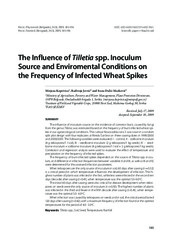Приказ основних података о документу
The influence of Tilletia spp. inoculum source and environmental conditions on the frequency of infected wheat spikes
Uticaj izvora inokuluma Tilletia spp. i uslova sredine na učestalost zaraženih klasova
| dc.creator | Koprivica, Mirjana | |
| dc.creator | Jevtić, Radivoje | |
| dc.creator | Dulić-Marković, Ivana | |
| dc.date.accessioned | 2021-04-26T18:30:12Z | |
| dc.date.available | 2021-04-26T18:30:12Z | |
| dc.date.issued | 2009 | |
| dc.identifier.issn | 1820-3949 | |
| dc.identifier.uri | http://fiver.ifvcns.rs/handle/123456789/695 | |
| dc.description.abstract | The influence of inoculum source on the incidence of common bunt, caused by fungi from the genus Tilletia, was estimated based on the frequency of bunt infected wheat spikes in our agroecological conditions. The cultivar Novosadska rana 5 was sown in a random split plot design with four replicates at Rimski Šančevi on three sawing dates in 1999/2000 and 2000/2001. The following variables were evaluated: I - control, II - soilborne inoculum (4 g teliospores/1 l soil), III - seedborne inoculum (2 g teliospores/1 kg seeds), IV - seedborne inoculum + soilborne inoculum (4 g teliospores/1 l soil + 2 g teliospores/1 kg seeds). Correlation and regression analysis were used to evaluate the effect of temperature and precipitation on the frequency of infected spikes. The frequency of bunt infected spikes depended on the source of Tilletia spp. inoculum, and difference in infection frequencies between variables II and III, as well as III and IV, were determined for the assessed infection parameters. When teliospores are the only source of inoculum in soil, 60 days after sawing (r>+0.52) is a critical period in which temperature influences the development of infection. The highest number of plants was infected in the first, while less were infected in the second ten days (decade) after sawing (r>0.41), when temperature was the optimal 5.0-6.0ºC. The initial 60 days after sawing were also critical for disease development when teliospores on seeds were the only source of inoculum (r>+0.50). The highest number of plants was infected in the third and fewer in the fifth decade after sawing (r>0.41), when temperature was the optimal 5.0-6.0ºC. When infection was caused by teliospores on seeds and in soil, the critical period lasted 120 days after sawing (r>0.42), with a maximum frequency of infection found at the optimal temperatures for the period of 4.0- 5.0ºC. | en |
| dc.description.abstract | Uticaj izvora inokuluma na pojavu glavnice pšenice koju prouzrokuju gljive roda Tilletia u našim agroekološkim uslovima praćen je, između ostalih, ispitivanjem parametra infekcije: stepen zaraženosti klasova. Sorta Novosadska rana 5 je sejana po split plot metodu u tri roka setve sa 4 ponavljanja na lokalitetu Rimski Šančevi tokom 1999/2000. i 2000/2001. godine. Ispitivane su sledeće varijante: I - apsolutna kontrola, II - zemlja infestirana teleutosporama (4 g teleutospora/1 l zemlje), III - seme infestirano teleutosporama (2 g teleutospora/1 kg semena) i IV - zemlja infestirana teleutosporama + seme infestirano teleutosporama (4 g teleutospora/1 l zemlje + 2 g teleutospora/1 kg semena). Izvršena je korelaciona i regresiona analiza ispitivanog parametara infekcije u odnosu na temperaturu i padavine. Stepen zaraženosti klasova je zavisio od izvora inokuluma Tilletia spp., a uočene su razlike u nivou infekcije između varijanti II i III, kao i III i IV. Kasniji rokovi setve (drugi i treći) su uticali značajno na ispitivani parametar infekcije, ali između njih nisu utvrđene značajne razlike. Kritični period u kom temperature utiču na ostvarivanje infekcije u uslovima kad su teleutospore u zemlji jedini izvor inokuluma traje 60 dana nakon setve (r>+0,52). Najveći broj biljaka je zaražen u prvoj i nešto manje u drugoj dekadi posle setve (r>0,41), pri čemu je optimalna temperatura u tom periodu iznosila 5,0-6,0ºC. Prvih 60 dana nakon setve je, takođe, kritičan period za ostvarivanje infekcije u uslovima kad su teleutospore na semenu jedini izvor inokuluma (r>+0,50). Najveći broj biljaka je zaražen u trećoj i nešto manje u petoj dekadi posle setve (r lt -0,45), pri čemu je optimalna temperatura u tim dekadama iznosila 6,0-7,0ºC. U uslovima kad infekciju pšenice ostvaruju teleutospore prisutne na semenu i u zemlji kritičan period traje 120 dana posle setve (r>+0,42), pri čemu je maksimalna infekcija ostvarena pri optimalnoj temperaturi 4,0-5,0ºC. | sr |
| dc.publisher | Institut za pesticide i zaštitu životne sredine, Beograd i Društvo za zaštitu bilja Srbije, Beograd | |
| dc.rights | openAccess | |
| dc.rights.uri | https://creativecommons.org/licenses/by-sa/4.0/ | |
| dc.source | Pesticidi i fitomedicina | |
| dc.subject | Tilletia spp. | en |
| dc.subject | soil | en |
| dc.subject | seed | en |
| dc.subject | temperature | en |
| dc.subject | rainfall | en |
| dc.subject | Tilletia spp. | sr |
| dc.subject | zemlja | sr |
| dc.subject | seme | sr |
| dc.subject | temperatura | sr |
| dc.subject | padavine | sr |
| dc.title | The influence of Tilletia spp. inoculum source and environmental conditions on the frequency of infected wheat spikes | en |
| dc.title | Uticaj izvora inokuluma Tilletia spp. i uslova sredine na učestalost zaraženih klasova | sr |
| dc.type | article | |
| dc.rights.license | BY-SA | |
| dc.citation.epage | 196 | |
| dc.citation.issue | 3 | |
| dc.citation.other | 24(3): 185-196 | |
| dc.citation.rank | M51 | |
| dc.citation.spage | 185 | |
| dc.citation.volume | 24 | |
| dc.identifier.doi | 10.2298/PIF0903185K | |
| dc.identifier.fulltext | http://fiver.ifvcns.rs/bitstream/id/1541/692.pdf | |
| dc.type.version | publishedVersion |


